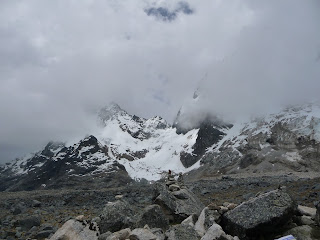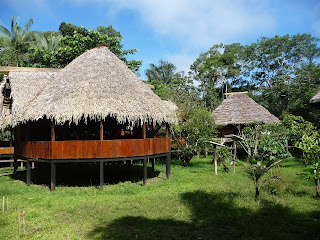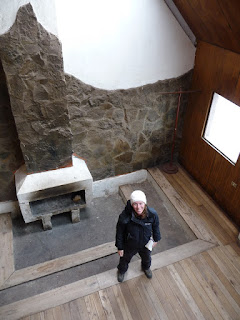The next morning we managed to share a taxi to the Hydroelectric Dam (where the railway to Machu Picchu starts) with some Australian honeymooners and there guide. The station was basically just a collection of huts clustered on one side of the trucks. Amongst these was hidden a ticket office, where only locals could buy tickets. The train was something else, far cry from the creaky wooden seats we had travelled on the last time. However, the luxury of the carriage was reflected in the price an there was now a clear and deliberate segregation between locals and tourists. for tourist there was no opting to travel coach, there were just degrees of expense.
This was the herald of things to come in Agua Calientes, which has seemingly been renamed “Macchu Pichu Peublo”. As the train pulled in the market stools that had lined the dirt road next to the tracks were gone. Instead iot was now more like entering an exclusive ski resort. Roads and pavements expensively paved, lined with exclusive shop, restaurants and hotels. It is by no means unpleasant, but it has become, much like Cusco, an international tourist outpost, that now has little in common with the way the most of the country is.
From the station the town extends up hill, the further up hill you go, the cheaper the accommodation becomes - consequently ours was a long way uphill. Having dumped our stuff at the hostal, we sat on a terrace at on the main street and watched the passersby. The tourists reflected the new upmarket ambiance of the place - the grungy 19 year-old backpackers intent on finding themselves were still there, but their numbers has been diluted by a huge increase in prosperous looking “silver-travellers”. Newly retired baby boomers, seeing the sights whilst from the comfort of luxury hotels and up market hostels. They were also joined by vast swathes of Peruvian tourists and school parties, which was new. The last time I was here, it was 19 old gringo central, the only older people were hippies and the Pervuvians around were those that worked there.
The next morning we got up obscenely earlier and got the bus up the hill rather than walking - ten years earlier, we would definitely have walked - this must be how middle age creeps ups on you.) In-spite of the unreasonable hour, the entrance was thronged with people and we bumped into our Australian honeymooners again, who kindly invited to join there guide for a tour of Macchu Pichu. This was just as well, because we entered the site the hillside was completely swathed in mist, so we dutifully trailed the guide around the sight, lectured on the history as the mist started to lift. That too seems to have changed since the last time I visited - although this version must be good, as the guides now have to passed a exam before they get certified to lead tourists around the site.
As the tour ended the cloud lifted and we were treated to a full view of the site which still takes your breath away as it perches silently on the mountain side, terraces dropping away either side into vertiginous slopes. There may be more people, and a slicker operation, but the site is no less impressive. In a strange way it is a combination of the situation and the way it is build that makes it seem more ancient than it is - as you get lost in the romanticism of Hiram Bingham lost city, you have to remind yourself that although this feels of an age with the pyramids and the acropolis, it is incredibly recent in comparison. Macchu Picchu was being built in the mountains at the same time the Tudors reigned in Britain, thousands of years after the pyramids and hundreds of years after the construction of Westminster Abby and the great Gothic European Cathedrals of the middle ages. However despite its relatively recent origins, it somehow feels more ancient that the Gothic cathedrals - and on a par with the pyramids.
As it cleared, we climbed Hyauna Picchu, which now requires a specialist permit and is clogged with overweight and out of breath tourists crawling to the top. The last time, I was there, the only people who climbed it were me and Billy. The climb is still worth when you get to the top, even if you have to share the summit with other people.
We got the train out of Agua Calientes the next morning and jumped off at Ollantaytambo to catch a taxi back to Cusco. This proved entertaining, as our driver seemed determined to complete the trip in the shortest time possible with not stopping, even at police check points! This only lasted so long and we were eventually chased and pulled over by the police who insisted that he accompany them to the Station. This was the end of our ride, however our taxi driver was not going to abandon us and waved down another taxi overcrowded with people and crops which took us the rest of the way at a slightly more sober pace.
Arriving back in Cusco, I broke a cardinal rule and succumbed to the convenience of the new McDonald's on the Plaza de Armes (there is only so much Lomo Saltado you can eat). I was duly punished and spent the next 3 days in riding the porcelain chariot and generally feeling awful.
































































